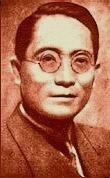|
NICANOR ABELARDO
Exponent of the Kundiman
(Feb 7, 1893 -March 21, 1934)
Nicanor Abelardo was born in San Miguel de Mayumo,
Bulacan, the eldest of eight children of Valentin Abelardo and Placida
Santa Ana. His formal Education was desultorily obtained. He attended the
town school in San Miguel and later on attended several scholls in Manila,
finishing his primary course in 1905 at the Quiapo Primary School. He
enrolled at the Conservatory of Music, University of the Philippines when
it opened in 1916, receiving his teacher's certificate in Science and
Composition in 1921. The following year, he finished a post graduate
course. In 1931, he received a grant from the University of the
Philippines which enabled him to go abroad and pursue advanced musical
studies at the Chicago Musical College. He returned to his native country
in 1932 and was granted the Master's Degree in absentia after fulfilling
academic requirements at the National University.
Throughout his life, Abelardo had to work to support himself and his own
family. He also supported his younger sisters. He held all types of odd
jobs-first as pianist in small and low class theaters, then as orchestra
conductor of bigger and better class theaters. During his students days,
he held assistantship in solfeggio and harmony and in his junior year in
1919, he was appointed instructor "based solely on merit and recognition
of ability." At the same time, he had to supplement his income and worked
as a pianist and orchestra director of the Lerma Cabaret. After his
graduation he directed a Jazz band at the Manila Hotel.
In 1924, he was appointed head of the Department of Composition at the U.P.
Conservatory. For financial reasons he took in pupils outside of teaching
hours and became director of the Sta. Ana Cabaret. This strenous schedule
took a heavy toll on his health. Abelardo died on March 21, 1934, leaving
six children and a wife, Sixta Naguiat.
E. Arsenio Manuel lists 149 musical compositions by Abelardo. As a
composer he was conscious of the wealth of native elements that were
waiting for the artists hand to transmute into more subtle expressions.
But it was his kundiman text and music were so perfectly matched-the
melodies so successfully conveyed his fame, however will not rest solely
on his achievement as a composer but also of his great ability as a
teacher.
|

